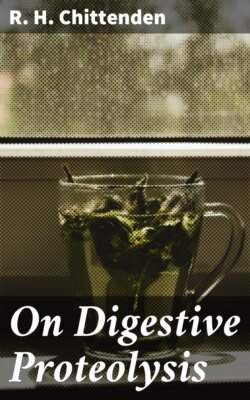On Digestive Proteolysis

Реклама. ООО «ЛитРес», ИНН: 7719571260.
Оглавление
R. H. Chittenden. On Digestive Proteolysis
On Digestive Proteolysis
Table of Contents
PREFACE
LECTURE I
THE GENERAL NATURE OF PROTEOLYTIC ENZYMES AND OF PROTEIDS
INTRODUCTORY
THE GENERAL NATURE OF PROTEOLYTIC ENZYMES
THE GENERAL NATURE OF PROTEIDS
LECTURE II
PROTEOLYSIS BY PEPSIN-HYDROCHLORIC ACID, WITH A CONSIDERATION OF THE GENERAL NATURE OF PROTEOSES AND PEPTONES
PROTEOLYSIS BY PEPSIN-ACID
SOME PHYSIOLOGICAL PROPERTIES OF PROTEOSES AND PEPTONES
LECTURE III
PROTEOLYSIS BY TRYPSIN—ABSORPTION OF THE MAIN PRODUCTS OF PROTEOLYSIS
PROTEOLYSIS BY TRYPSIN
ABSORPTION OF THE MAIN PRODUCTS OF PROTEOLYSIS
FOOTNOTES:
Отрывок из книги
R. H. Chittenden
Being the Cartwright Lectures for 1894
.....
The general tenor of Meissner’s results is shown in the description of a row of products as characteristic of the proteolytic action of pepsin-acid on proteid matter. In other words, there was a clear recognition of the fact that proteid digestion in the stomach, through the agency of the ferment pepsin, is something more than a simple conversion of the proteid into one or two soluble products. The several bodies then isolated were named parapeptone, metapeptone, dyspeptone, α, β, and γ peptone; names now seldom used, but significant as showing that at this early date there was a full appreciation of the fact that digestive proteolysis as accomplished by the ferment pepsin is an intricate process, accompanied by the formation of a series of products which vary more or less with the conditions under which the digestion is conducted.
This was the commencement of our more modern ideas regarding digestive proteolysis, but only the commencement, for it ushered in an era of unparalleled activity, in which Brücke, Schützenberger, and Kühne each contributed a large share toward the successful interpretation of the results obtained. Further, knowledge regarding the proteid-digesting power of the pancreatic juice was rapidly accumulating, thus broadening our ideas regarding digestive proteolysis in general. Corvisart18 had called attention to the proteolytic power of the pancreatic juice in 1857, and although his observations were more or less generally discredited for a time, they were eventually confirmed by Meissner,19 Schiff, Danilewsky,20 and Kühne,21 the latter particularly contributing greatly to the development of our knowledge concerning this phase of digestive proteolysis. The proteolytic power was proved to be due to a specific ferment or enzyme, now universally called trypsin, which digests proteid foods to the best advantage in the presence of sodium carbonate. Digestive proteolysis in the human body was thus shown to be due mainly to the presence of two distinct enzymes, the one active in an acid fluid, the gastric juice, the other in an alkaline-reacting fluid, the pancreatic juice, but both endowed with the power of digesting all varieties of proteid foods, with the formation of a large number of more or less closely related products.
.....